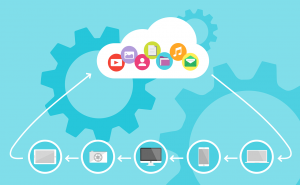In this era of Information Technology, executives are not looking at cloud as just a tool to leverage their infrastructure anymore. They are now exploring optimal ways to use cloud technology in order to strategize their business goals in 2018. The cloud journey began from a personal storage system to an organization’s storage system and that’s how cloud has humbly evolved giving large organizations the ability to adopt to connect better.
However, a major challenge that cloud service providers face today is to prove their security ability. The industry is still hesitating to move their entire data to cloud. But it seems like 2018 will be the year when all these aspirations about safety are cast aside and cloud adoption rises in proportion to its benefits like mobility, greater than before efficiency, cost-effectiveness, simplified collaboration and high speed connectivity.
Here are some numbers that will make cloud, the most relevant IT topic in 2018:
- More than 50% of enterprises will be adopting applications, platforms and services enabled by cloud in order to drive digital revolution by the end of 2018, predicts a recent survey by Forrester.
- Cloud computing spending is expected to grow at a whopping rate of 6x the rate of IT spending through 2020 and it is found to be growing at 4.5 times the rate of IT spending since 2009, says an IDC research report. The same report also predicts that half of the IT spending will be cloud-based by the end of 2018, reaching up to 60% of entire IT infra, and 60-70% of all applications, technology, and services spending by 2020.
- The Silicon ANGLE determines that cloud spending for enterprises is growing at a 16% CAGR (compound annual growth rate) from 2016 to 2026.
Which cloud trends should strategic businesses and IT executives prepare for in 2018?
1. Massive growth in cloud solutions
A recent study from Bain & Co, KPMG and Statistic says that as long as cloud is growing, it’s natural for Software as a Service (SaaS), Platform as a Service (PaaS), Infrastructure as a Service (IaaS), function as a service (FaaS), backend as a service (BaaS) to grow aggressively too. SaaS is a software license service on a subscription basis and it’s hosted centrally. Currently, this sector is influenced by key players like Google Apps and Salesforce, and new companies are likely to jump in the competition. The growth rate for SaaS is predicted to be 18% CAGR by 2020. The PaaS offers a safe platform which gives customers a chance to develop, launch and manage applications in a modest way rather than having to build and maintain the infra by yourself. The growth rate of PaaS has been remarkable; it has been predicted that the adoption rate will escalate from 32% in 2017 and is supposed to reach 56% in 2020. IaaS provides a virtual resource service on the web and is dominated by Google Compute Engine (GCE), Azure, Amazon Web, AWS and IBM Bluemix. IaaS market is predicted to go over $17B in 2018. We saw positive performance in cloud sector services. Hence, we can expect greater cloud sector growth in 2018 and later.
2. Continuous increase in cloud storage capacity
A total amount of about 370 EB (Exabyte) data is stored in data centers presently and the global cloud storage capacity at the end of 2017 was up to 600 EB. These numbers are set to amplify the total capacity of 1.1 ZB (Zettabyte) in 2018 which nearly doubles the storage available in 2017 according to a survey by Cisco. Sharing of families and friend’s storage is going to now become a common practice in 2018 and will be used in place of applications like Google Drive and Dropbox.
3. Server-less cloud computing is on the rise
The server-less technology that allows developers to build and run application services without managing any server or infrastructure will take the center stage in 2018. The merits of not having to manage any infra makes Server-less Cloud Computing a trend in 2018 as it allows developers to connect cloud services and improve efficiency. Comparatively less time and effort is required to manage server-less cloud computing and also, release of new updates is easy and less complex.
Cloud technology will continue its growth in 2018 and beyond and there’s no doubt in it. So organizations must position themselves in such a way such that they can actively participate in early cloud adoption, security and further development to achieve business goals in IT.
4. Growing demand for cloud-based container system
An alternate to a virtual machine, the cloud-based container system as service, is in demand. It allows apps to be deployed in a quick and straightforward manner. It also delivers better infra security and allows quick releases of new software modules and features to run smoothly. It’s possible for CSPs to offer hosted container management services and at the same time segregate the platforms from each other using cloud container systems. The year 2018 will see full implementation of cloud container system by key players in the technology sector.
5. Artificial Intelligence & Machine Learning (AI/ML) will take center stage
AI & ML are now set to revolutionize cloud solution. Major companies in the Artificial Intelligence & Machine Learning division are ?IBM, Google, Microsoft and Amazon Web Services?. These tech giants are already making use of both these technologies to deliver cloud-based services geared to drive business growth.
6. The rise of 5G network and upgraded internet speed
The most awaited fifth-generation network (5G) is surely set to rule 2018. There is enormous amount of data generated on daily basis and the store rate has also increased tremendously, so internet speed also needs to be upgraded for a better user experience. And we know 2018 is likely to be the Gigabyte year where the transformation from LTE to 5G full capacity network will take place, and network providers are already working towards a better and faster connection to support cloud solutions and services to function seamlessly.

